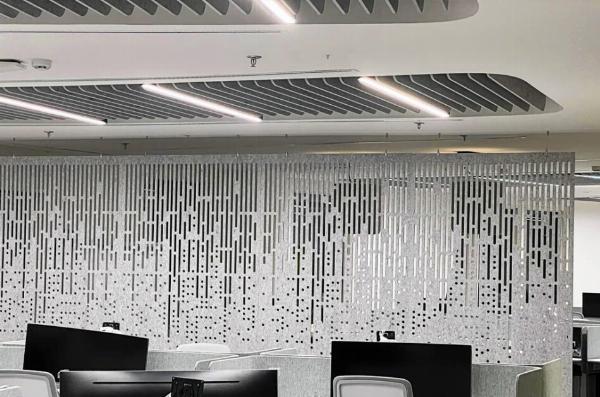Acoustic Panels and Workplace Productivity: The Science Behind Noise Reduction

Strong 8k brings an ultra-HD IPTV experience to your living room and your pocket.
In today’s fast-paced business world, creating a productive work environment is more crucial than ever. One often-overlooked factor that can significantly impact productivity is noise. Acoustic panels are increasingly being used in commercial spaces to tackle this issue. This article explores how commercial acoustic panels enhance workplace productivity through noise reduction and the science behind their effectiveness.
The Impact of Noise on Productivity
Noise in the workplace can be a major disruptor. It can lead to decreased concentration, increased stress, and lower overall job satisfaction. Several studies have highlighted the negative effects of noise on work performance. For instance, research published in the Journal of Environmental Psychology found that high noise levels can impair cognitive functions, such as memory and problem-solving skills.
Key Issues Related to Workplace Noise:
Distraction: Background noise, whether it’s conversations, phone calls, or machinery, can interrupt employees’ focus.
Stress: Constant noise can elevate stress levels, leading to burnout and decreased job satisfaction.
Communication Barriers: Excessive noise can make verbal communication difficult, resulting in misunderstandings and errors.
How Acoustic Panels Address Noise Issues
Commercial acoustic panels are specifically designed to absorb sound, reduce echoes, and manage noise levels. They are an effective solution for creating quieter, more conducive work environments. Here’s how they work:
Sound Absorption: Acoustic panels are made from materials that absorb sound waves. When sound waves hit the panel, they penetrate the porous surface and are converted into heat, reducing the overall noise level in the room.
Echo Reduction: Hard surfaces in a room, such as glass and concrete, can cause sound to bounce around, creating echoes. Acoustic panels help to minimize these reflections, resulting in clearer sound and less auditory clutter.
Noise Isolation: Panels can also be used to isolate noise from specific areas, such as meeting rooms or open-plan offices, preventing sound from traveling between spaces.
Scientific Principles Behind Acoustic Panels
The effectiveness of commercial acoustic panels is rooted in acoustics, the science of sound. Several key principles explain how these panels improve workplace environments:
Absorption Coefficient: This measures how well a material can absorb sound. Higher absorption coefficients indicate better sound absorption. Acoustic panels are designed with materials that have high absorption coefficients, making them effective at reducing noise.
NRC Rating: The Noise Reduction Coefficient (NRC) is a metric used to quantify the overall sound absorption performance of acoustic panels. Panels with higher NRC ratings offer better sound control and are more suitable for commercial applications.
Frequency Response: Acoustic panels are engineered to absorb a wide range of sound frequencies. Some panels are designed to target specific frequency ranges, addressing unique acoustic challenges in the workplace.
Benefits of Acoustic Panels for Workplace Productivity
Investing in commercial acoustic panels can yield significant benefits for workplace productivity:
Improved Concentration: By reducing background noise and echoes, acoustic panels help employees focus better on their tasks, leading to higher efficiency and output.
Enhanced Communication: Clearer speech and reduced noise levels facilitate better communication during meetings and collaborative work, minimizing misunderstandings and errors.
Reduced Stress Levels: A quieter work environment contributes to lower stress levels, creating a more pleasant and productive workplace.
Increased Job Satisfaction: Employees who work in noise-controlled environments are generally more satisfied with their work conditions, which can lead to lower turnover rates and higher morale.
Implementing Acoustic Panels in Commercial Spaces
To maximize the benefits of acoustic panels, consider the following implementation strategies:
Assess Acoustic Needs: Evaluate the specific acoustic challenges in your workspace. Identify areas with high noise levels or poor sound quality and determine the appropriate type of acoustic panels.
Choose the Right Panels: Select panels based on their material, absorption coefficient, and NRC rating. Consider factors such as panel size, design, and installation location.
Professional Installation: Proper installation is crucial for achieving optimal acoustic performance. Engage professional installers to ensure panels are correctly mounted and positioned.
Ongoing Maintenance: Regularly inspect and maintain acoustic panels to ensure they continue to perform effectively. Clean panels as needed and replace any damaged or worn panels.
Case Studies: Acoustic Panels in Action
Several companies have successfully implemented commercial acoustic panels to enhance workplace productivity. For example, a large tech company installed acoustic panels in their open-plan offices to address noise issues. The result was a noticeable improvement in employee focus and communication, leading to increased productivity.
Another case involved a law firm that used acoustic panels to create quieter meeting rooms. The panels reduced noise distractions and improved the clarity of discussions, resulting in more effective meetings and higher client satisfaction.
Conclusion
Commercial acoustic panels play a vital role in improving workplace productivity by addressing noise-related challenges. Through their sound absorption and echo reduction capabilities, these panels create a quieter, more focused work environment. The science behind acoustic panels—principles such as absorption coefficients, NRC ratings, and frequency response—demonstrates their effectiveness in managing workplace noise.
Investing in commercial acoustic panels is not just about enhancing acoustic comfort; it’s a strategic move that can lead to improved concentration, communication, and overall job satisfaction. As businesses continue to prioritize employee well-being and productivity, acoustic panels will remain an essential component of effective workplace design.
Note: IndiBlogHub features both user-submitted and editorial content. We do not verify third-party contributions. Read our Disclaimer and Privacy Policyfor details.


